

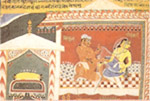
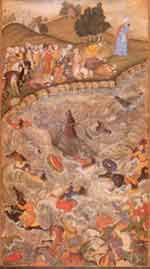
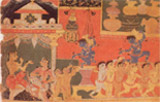
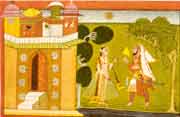

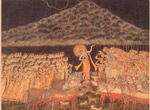
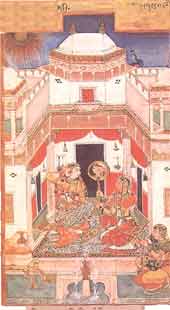
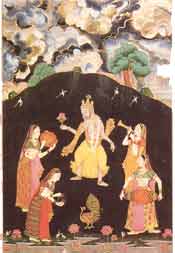
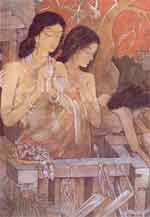
" ...as one of the greatest collections of Indian paintings, it should be universal centre of pilgrimage ,........"........
..........................
MORTIMER WHEELER
(Achelogogist
and former Director General of Archeology in India)
Bharat Kala Bhavan is reputed for its outstanding collection of Indian paintings. Scholars like Stelle Kramrish thought of this collection as one or the greatest if not greatest collection of paintings. The total acquisition is approximately 12,000 and it bears an all India character . Besides, it includes mediaeval paintings of Persia, Nepal and Tibet. The collection of paintings covers a period from the I1th century A.D. to the 20th century A.D.
The earliest examples of this section include dated palm leaf illustrated manuscripts of which the Museum has three sets. Of these, the manuscript entitled Pancha- raksha dated in the 9th regnal year of king Rama Pala happens to be the earliest. Painted in classical idiom as well as with certain mediaeval traits, these illustrations on palm leaf and on wooden covers mostly depict events from the life of the Buddha and male and female deities of Vajrayana Buddhism. An illustrated Astasahasrika Prajnaparamita dated 4th regnal year of king Gomindrapala i.e. circa 12th century A.D. is presented in the gallery .
The illustrated manuscript in paper appeared in the 14th-15th century A.D. Produced mostly in Western India, the themes of these manuscripts include Jaina, Hindu and secular narratives such as Kalpa Sutra, Uttaradhyayana Sutra, Kalakacharya Katha, Panchatantra, Balagopala Stuti (displayed), Prabodha Chandrodaya. Rati-rahasya, Durga Saptsati, Hari Katha, etc. Painted mainly with mediaeval traits emphasizing on angularity, pointed ness and jerky lines, these illustrations are devoid of rounded plasticity or shading. To this period, the Gallery includes two dispersed pages of a beautiful Kalpasutra produced at DevasanapadoBhandara. Illustrated folios of DurgaSaptasati of Pipalaner, six illustrated folios of Chandayan deserve special mention for their composition, color scheme and emotional fervors.
In the 16th century , the early phase of Rajasthani paintings became more popular than the Western Indian miniatures. To this period belongs the famous illustrated manuscript of Mrigavati which has two hundred fifty illustrations. Mention may also be made of a single page illustration of Chaurapanchasika, and an illustrated folio of Mitharam Bhagavata. Presented in the gallery these paintings evince notable changes and improvements made in the treatment of faces, eyes, gestures, postures and in the dresses and costumes.
In the second half of the 16th century , India witnessed the introduction of Mughal paintings. Mughal painting was evolved as an eclictic type in which style and mannerisms of Persian paintings and paintings of Western Indian School, Sultanate School, Central Asian School, Kashmiri, Tibetan, Nepali and European elements were mixed up. Thus was born Mughal miniature during the ruling period of emperor Akbar. Of the Mughal paintings in this section, mention may be made of displayed illustrations of Hamzanama painted on cloth, the Exodus of Moses, two illustrations of a manuscript entitled Iyar-e-Danish in which notable painters in the atelier of Akbar did superb paintings. These paintings were done with judicious .combination of colour, shadings and compositions. The pomp and grandeur of the Mughal court have been reflected through these illustrations.
The period of Emperor Jahangir (1605-1627 A.D.) marked a notable change in the tone and temper of Mvghal miniatures. The paintings evinced a sense of delicacy, a subdued colour scheme and a fascination for portraying animals and birds of rare types. Of the paintings of this period in this section, mention may be made of the painting entitled 'The Hermitage of Shaikh Phool by Bishandas presented in the gallery .
The paintings in the period of Shah Jahan (1628-1658 A.D.) evince the pomp and grandeur of Mughal court. The Museum has a number of notable paintings of this period. These include the portrait of Shah-Jahan, The Treaty of Quandahar, Shah Jahan in Court (displayed) Lady Painter in Zenana (displayed) Bharatiya Sundari (displayed) Mughal damsel, etc. Of these paintings some are historically important while others are artistically pleasing.
A large number of paintings. bears the Late Mughal traits and mannerisms. Of this group, mention may be made of the specimens entitled Sulaiman's Journey (displayed), Farrukhsiyar and Rajbai, Prince at a Village Well, Nisha Vihara by Niddhamal and Mughal beauty. Reference may also be made of twenty one illustrated pages of the manuscript called Padmavat reportedly painted in the period of Muhammad Shah (1735 A.D.). A few paintings ascribed as belonging to the Popular Mughal style in this period necessarily demand special attention. The Sangrahani Sutra, Ramayana, Ragamala paintings are worthy to be referred to in this connection. The Fire Ordeal of Sita is an unique creation of this popular style.
The Painting Section is justly famous for its large
and unique collection of Rajasthani miniatures. The, collection related
to Mewar School is particularly remarkable for its varied subject matter,
richness and superb execution. The gallery presents Nisardi's painting
of Malkauns Raga from a Ragamala series (1605 A.D.) that depicts robust
simplification, viril intensity and the judicious application of primary
colours. Mention may also be made of another Ragamala series and particularly;
of Sarang Raga presented in the gallery , that was painted by Sahabadin.
Other notable illustrations of this School includes Ramayana, Bhagavata
Purana, Panchatantra,Rasikapriya, Gita-Govinda, etc. The dated Bihari
Satsai folios (1719 A.D.) by artist Jagannatha, Krishna lifting Mount
Govardhana, Krishna Swallowing Forest Fire (late 18th century) are some
of the notable examples of this School.
The Section includes a very good and representative collection of Bundi
paintings. The illustrations on , Ragamala, Rasika-Priya, Bhagavata Purana,
Bihari Satsai, Barahmasa, Nayaka-Nayika Bheda and Royal portraitsare there
in this Section. Of these, Ragamala paintingsof Chunar and Nayika gazing
flying pigeons have been included in the gallery .The Kotah School was
famous for painting of hunting scenes, animal fights, etc. Mentionmay
be made of the painting showing a mad and Infuriated Elephant. Of the
Bikaneri School, the Museum has a unique painting called Vaikuntha. It
was painted by noted Bikaneri painter Ali Raja. Krishna killing Kesi is
-'C another important citation of this School which enriched the collection
of this Museum. The illustrated Surasagar of Jaipur and the illustrated
Bala Kanda from Ramayana, Jaipur sub-style, Krishna holding the mount
Govardhana of Kishangarh School are significant examples in this section.
The Gocharana pichhwai of Nathadvara School 1 is equally attractive and
deserves a special mention. Various other schools such as Datia, Sirohi,
Amber ,Jodhpur are also represented with their paintings in this gallery
.Special mention may also be made of paintings of Malwa School. The Museum
has a huge collection of this School. The illustrations of this School
include various themes such as the Ragamala, Ramayana, Bhagavata Purana,
Padmavat, Amaru-Sataka, Rasika-Priya and Durga Saptasati. The Ragamala
Series (1650 A.D.), the Ramayana illustrations (1640 A.D.) and the Bhagavata
Purana (1700 A.D.) are represented in the gallery with Ragini Asavari,
Raffia Killing Kabandha and Krishna slaying Aghasura, respectively.
The Museum
feels proud of having a rich collection of Pahari paintings covering a
period between 17th-19th century A.D. Each small and big Himalayan state
maintained an atelier of painters and developed a school of paintings.
Basohli, Mankot, Suket, Nalgarh, Guler, Kangra, Jammu, Jasrota, Kulu,
Mandi, Garhwal, Vilaspur , Nurpur, Sangri are some such states which evolved
a style and contributed local colours, idioms and traits.
The Museum has a few pages of
illustrated Rasamanjari from Basohli School. The colophone page with the
illustration of Sakshat Darsana, The Vak-Vidagdha Nayika (displayed) are
some of its unique examples. Beside this dated Rasamanjari folios (1694
A.D.), the Museum has paintings on the same theme belonging to a later
period (dated 1710-1735 A.D.). An illustration of Gita Govinda (1730 A.D.)
attributed to Manak, Mrityunjaya Siva, Radha offering butter milk to Krishna,
Ragamala and Bihari Satsai illustrations are some other notable examples
of Basohli paintings in this Museum.
.
The paintings of
Kangra School reached their zenith , with its remarkable
examples in the court of king Sansar Chand. The spirit of beauty
and the romantic appeal of the miniatures were very subtly and delicately
represented. Of the most outstanding. examples of this school, the Museum
has a few folios of Gita Govinda (c. 1790 A.D.), illustrations from Bhagavata
Purana (Exchange of Babes, Water Sport of Krishna and cowherd girls) the
illustration of Bihari Satsai (1790 A.D.), Barahmasa, Radha Krishna, Tryst,
Holi, Virahini Nayika., Radha Krishna within lotus pond, Krishna killing
Aghasura, etc. are remarkable for their aesthetic appeals, soothing colour
schemes and skilled compositions. Most of these paintings are displayed
in the painting gallery. Sohini crossing the river (1775 A.D.) of Guler
School, Abhisarika Nayika and illustrated Rukmini Mangal of Garhwal School,
Rasa Panchadhyayi (1790-1800 A.D.) of Kulu attributed to artist Bhagavan,
illustrated Dasamaha-vidya by the artist Molaram, Durga Saptasati of Mandi
School are equally famous. The painting showing Raja Siddhasen of Mandi
incarnated as,Siva is another masterpiece of Mandi School. Mention should
also be made of a series of paintings of Ramayana related to Sangri-Kulu
areas. These are also remarkable for their composition, colour scheme
and emotional appeals. Of the Jammu School, two remarkable paintings '
namely, Balwant Singh on the terrace and Balwant Singh on the ship painted
by famous Paharipainter Nainsukh have enhanced the quality of the collection
of this Museum. No less remarkable is the painting of Balawant Singh in
Thakuradvara with an inscription in Takri.
Incidentally, a reference needs to be made of six leaves of Shah-nama of 15th century belonging to the Sultanate School. The displayed Sri Raga, the Triveni Ragini and the portrait of Abdulla Qutub Shah in the reserve, are notable paintings of Deccani School. The 18th century Ragamala paintings of Hyderabad are superb for their compositions and colour schemes. The illustrated Ganjifa (playing cards) of Mysore are fascinating from the iconographic point of view as well as for the delicate execution within a small area. Mention should also be made of Thangka paintings of Nepal and Tibet. Of these, the most outstanding is the Thangka datable 1400 A.D. showing Dhyani Buddha Ratnasambhava (on view). The Tantrik Scroll painting (Kala Pustaka) from Nepal dated 1765 A.D. painted during the reign of Raja Jai Prakash Malla Bahadur happens to be a rare collection which includes almost all the Tantrik deities, their iconographic representations and their related yantras.
During the 19th century A.D. India witnessed the decadence of traditional Indian paintings and the introduction of Company School in which Indian painters imbibed inspirations from Western techniques. Bharat Kala Bhavan has a huge collection of Company paintings of this period painted on paper, ivory , mica, glass and these mostly hail from Avadh {Lucknow), Banaras, Patna and South India" The theme of these paintings include portraits, architecture, animals, birds, flowers, fruits, means of transport, men engaged in different trades or profession, fairs and festivals, landscapes and daily life. A few of these are included in the gallery .
Museum has also a good collection of Modern Indian paintings and particularly of Neo-Bengal School. Of this particular phase of Indian paintings, the Museum has the paintings of Abanindranath Tagore, Gaganendranath Tagore, Nandlal Bose, Kshitindranath Mazumdar Sailendranath Dey, Asit Kumar Haldar, Jamini Roy and any others. A representative collection of this phase is.also on view in the gallery .The collection of other notable painters include the paintings of M.F. Hussain,K. K. Hebber, M.B.Chugtai, Sudhir Khastagir, Bendre, 4 Dinkar Kaushik and many other painters of repute.